|
TennisOne Lessons


Observations on Ball Watching
Doug King
As difficult as it is to accurately detail the nuances of the physical movements of a tennis stroke, it pales in comparison to the complexities involved in watching the ball that you are going to hit. This is because watching the ball not only involves keeping your eye on the ball but also keeping your mind on the ball.
Many (especially Scott Ford on TennisOne in his series “Playing In The Zone”) have written extensively and luminously about “ball watching.” So, staying in theme with Jim McLennan’s Spring Training schedule for January (Back to the Basics), I would like to chime in with my own personal observations about ball watching, both borrowing on, supporting, and sometimes reinterpreting what Jim, Scott, and others have said before.
The first thing I would suggest in the analysis of ball watching is the creation of two separate ball watching functions; physical and mental. It amounts to discussing how to get the eyes to physically perform the act of seeing better, and second is getting the mind to be aware of what the eyes are seeing. It can be illustrated by the phenomena that we are all aware of which is reading a paragraph in a book and then realizing that you have no idea of what your eyes just looked at because your mind was somewhere else.
I will divide this article into two sections. The first will deal with the physical aspects of ball watching and the second installment (if Jim will allow me to take liberties with his training schedule) will deal with the mental and emotional aspects of ball watching.
Part I: Physical Ball Watching
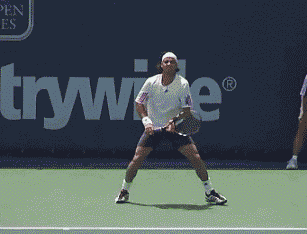 We may be over looking the greatest source of watching the ball information and it may be right in front of us.
We may be over looking the greatest source of watching the ball information and it may be right in front of us. |
The thing that has occurred to me (and perhaps many others) is that as much in-depth study that we do on the subject of ball watching, we tend to overlook the most obvious and accessible source of material that could possibly be available. I am talking about tennis line judges. It is my suggestion that if we are interested in how to see the ball more clearly what better place to look than to the people whose sole job is to do exactly that and nothing more.
I don’t know about you but for the most part I am very impressed by the accuracy and consistency displayed by the line judges. The newly instituted Player Challenge review system has confirmed this and has done nothing but enhance my opinion of how the judge’s do their jobs. Thus it would only make sense to look into the techniques that linesmen use to make their calls and see if there are elements that transfer to the playing side.
Rule One: Eliminate Movement
When we study the technique that linesmen use we can see one dominant theme and that is that physical movement will detract from a clear call. There are two things that the umpire learns in order to minimize movement: one is to stabilize the body through posture and the second is to stabilize the eyes themselves by learning how to separate ball watching into two separate techniques; tracking and spotting.
Posture And Hand-Eye Coordination
In the old days we used to have all of the line judges in individual chairs. The chairs allowed the judges to remain in a well balanced, stable position, which kept the body and the head quiet. Today the only judges we typically see in chairs are the service linesmen. This is because they have only one call to make and it is an unobstructed view. The base and side line judges are more often standing, allowing them to shift in order to adjust to a player’s position that may interfere with their line of sight. But if you watch, you will notice that there is a specific posture that a line judge assumes when making a call. That posture is with the feet approximately shoulder width apart, the knees flexed, and the hands on the knees.
Because the line judges are not responsible for hitting the ball they are able to stay much more quiet than the players themselves, affording them a better look at the ball. This is a theme that we will see come up again and again (especially in Part II) and that is the relationship between stillness, detachment, and objectivity in seeing the ball clearly.
In fact the terminology that we use for this phenomena, “hand-eye-coordination,” bespeaks of this relationship between the still parts of the body (eyes) and the moving parts of the body (hands) and the conflicting relationship between them that requires coordinating. Seeing and moving are mutually exclusive to each other, that is, the more we move the less clearly we see and the more effort we put into seeing the less we will be inclined to move.
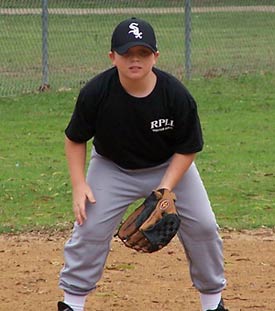 Classic ready position: A wide base and a low center of gravity provides stability and balance.
Classic ready position: A wide base and a low center of gravity provides stability and balance. |
Aligning the Body and Breath for Balance
Another aspect of stabilizing the body is the breath. Umpire and linesmen know the importance of relaxing in order to stabilize and steady the body. The body works like any other object when it comes to finding stability. A wide base and a low center of gravity will provide stability and balance. Think of the body as a patio umbrella. Two things will give the umbrella balance - being aligned over the base (minimizing leaning) and concentrating more weight at the base. The body works exactly the same way. Posture is what aligns the body over the base (the feet), and the way that weight is concentrated into the base is through relaxing, or yielding to gravity. This is done by flexing the knees and especially through the breath.
Shallow breathing will tend to hold tension higher in the body and create a higher center of gravity. We tend to become “top heavy” anytime we accumulate too much mass, activity, or stress in the upper body and we compromise balance. By breathing from lower in the diaphragm, we can maintain a lower center of gravity and improve balance. This is why it is not only important to learn to relax but also to get into good enough shape so that you are not “short of breath.”
(Note: see my article “Back to the Basics,” for more on hand-eye-coordination, moving, and seeing the ball)
Ball Tracking and Ball Spotting
The real aspect of keeping steady that line judges learn is the different techniques that they employ when following the ball with their eyes. Line judges do not watch the ball all of the time. In fact, in order to see the ball optimally as it hit’s the court, they must actually take their eyes off of the ball a moment before it lands and instead, stare into the area they have predetermined that the ball will land into. It works something like this:
A service line judge will watch the server as he tosses the ball up. He will focus on the ball as it is tossed and hit. He will then move his focus to the line that he is calling and instead of trying to track the ball he will focus his gaze into the area of the line. The judge will be able to see the ball bounce and it’s relation to the line much more clearly if the head and eyes are held steady as the ball enters into the field of vision. The ball will seem clearer and slower.
During a rally, or on slower serves, the judge will watch the ball in flight (track the ball) long enough to know whether the ball is going to land close to the line (“threaten” the line) and then time his vision so as to advance his focus in front of the ball in flight and steady it onto the area of the line he has anticipated the ball will bounce. He will then keep his eyes and focus steady in that area and wait for the ball to enter his field of vision. That way he will see the ball bounce more clearly (spot the ball) without the disruptive movement of the head and eyes that is inherent in ball tracking.
This may work fine for a line judge who doesn’t have to hit the ball and get ready for the next shot, but the real question is whether or not this is a technique that we can translate into tennis play. I would suggest that this is a technique that we see in all sports involving hitting a moving ball whether it is golf, baseball, tennis, or others. A golfer is told to look at the divot after he hits the ball, baseball players are told to tuck their chins into their shoulders, and tennis players are told to keep their heads down on strokes.
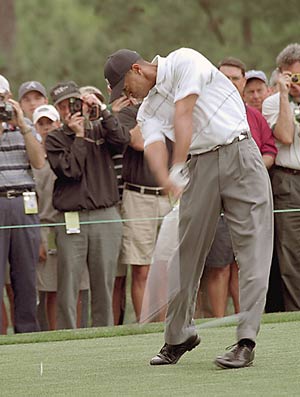 Head still, Tiger Woods remains focused on contact even after the ball is gone.
Head still, Tiger Woods remains focused on contact even after the ball is gone. |
We see evidence that there are overlapping physical patterns between line calling technique and ball striking technique when it comes to watching the ball. The emphasis on posture and the way the head and eyes are locked into contact suggest that there are similar techniques being employed. The inference that we can draw is that our attempts to watch the ball at all times and lock us into “tracking vision” may undermine our ability to shift into “spotting vision,” which is optimal for seeing the ball the clearest at the most critical time - when we are contacting it.
By understanding the technique of the line judge, we may deduce that it is necessary to somehow take our eye off of the ball and shift the focus slightly ahead to the equivalent of the court line - which for the tennis player would be the contact point. This, I believe, is what Scott Ford refers to as recognizing your “window.” We will study this hypothesis further in Part II and shed an entirely different light on “seeing the ball at contact.”
Developing Proper Ball Watching Form
Since ball watching has a physical aspect to it (posture, moves, and positions) there is, what we can call “ball watching form.” This is not different from stroking form, but becomes integrated into it. The way the head turns to track and fix to spot is the essence of this form.
To develop a sense of this form, I have outlined a few exercises.
First, drop a ball, hit it over the net, and try to keep your focus on a selected point on the ground (a leaf, a mark, a part of a line) that is in line with your line of vision as you are looking at the ball at contact. By keeping the focus back you are deliberately delaying the tracking vision that occurs after contact.
Second is to hit a one handed stroke (forehand or backhand) off of a hand-fed ball and use your non-hitting hand to block your vision of the ball as it is approaching your contact zone. Adjust your hand so that you start somewhat broad and then decrease your tracking vision with subsequent feeds.
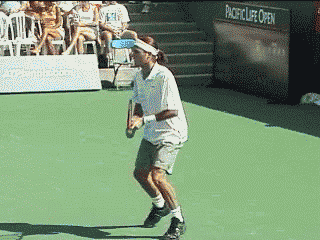 Federer focuses his eyes on the contact slightly before the ball arrives and remains fixed on it long after the
Federer focuses his eyes on the contact slightly before the ball arrives and remains fixed on it long after the
ball has left. |
Finally try to incorporate these exaggerated exercises into a ball watching form that starts to produce more awareness of both the ball and the contact zone and ultimately, more consistent contact.
Summation
The irony is not lost on me that we blindly ignore what could be the most revealing source of experience and information on the crucial subject of ball watching. The elevation of the oft maligned line judge from a menial subordinate to a valued teacher has a somewhat perverse but intriguing allure. I, at least, think that it deserves a closer look.
In Part II we will continue to explore the dynamics of ball watching and expand into concepts of “ball watching rhythm and feel.“
Your comments are welcome. Let us know what you think about Doug King's article by emailing us here at TennisOne.

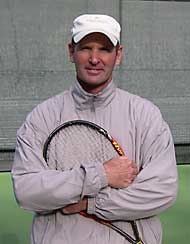  Doug King studied with legendary tennis coach Tom Stow and was a
former California State Men's Singles Champion
and the former number one men's player of Northern California. Doug King studied with legendary tennis coach Tom Stow and was a
former California State Men's Singles Champion
and the former number one men's player of Northern California.
Doug is one of the country's foremost tennis teaching innovators. Founder of Acceleration Tennis, a revolutionary teaching system, King is leading the way in reinterpreting the traditional tennis model.
Doug King is currently Director of Tennis at Meadowood Napa Valley ( www.meadowood.com ), a Relaix Chateau Resort in St. Helena , CA .
For more information on Acceleration Tennis please email Doug King at dking@meadowood.com.
|






 Doug King studied with legendary tennis coach Tom Stow and was a
former California State Men's Singles Champion
and the former number one men's player of Northern California.
Doug King studied with legendary tennis coach Tom Stow and was a
former California State Men's Singles Champion
and the former number one men's player of Northern California.